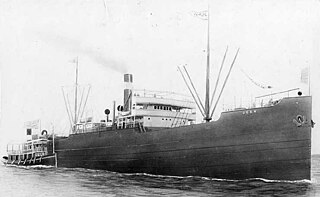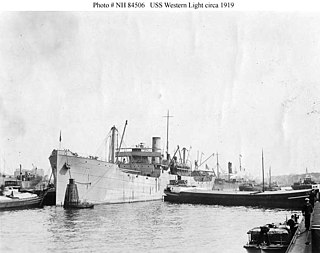
USS Zaca (ID-3792) was a steel-hulled, single-screw freighter that served in the United States Navy from 1918 to 1919. She was the first ship to serve by that name.

USS Federal was a freighter acquired by the U.S. Navy during World War I. She was completed at the end of the war and supplied Allied troops in Europe with food and horses, and, on return trips to the United States, brought troops back home. After three round transatlantic trips in supporting the troops, she was returned to the U.S. Shipping Board, which eventually sold her in 1937. She then became the British freighter Federlock which was captured in 1941 by the Japanese, who renamed the ship the Hakusan Maru. The ship sailed carrying Japanese cargo until sunk by an American submarine in 1945.
USS Hisko (ID-1953) was a tanker that served in the United States Navy from 1917 to 1919.
Wassaic was a steam cargo ship built in 1918-1919 by Los Angeles Shipbuilding & Dry Dock Company of San Pedro for the United States Shipping Board (USSB) as part of the wartime shipbuilding program of the Emergency Fleet Corporation (EFC) to restore the nation's Merchant Marine.

USS Jean (ID-1308) was a cargo ship that served in the United States Navy from 1918 to 1919.

USS Suwanee (ID-1320) was a United States Navy transport in commission in 1919. She was the second ship to carry her name.

USS Kermanshah (ID-1473) was a cargo ship that served in the United States Navy from 1918 to 1919.

USS Alaskan (ID-4542) was a United States Navy cargo ship and troop transport in commission from 1918 to 1919.

USS Arizonan (ID-4542A), also written ID-4542-A was a United States Navy cargo ship and troop transport in commission from 1918 to 1919.

USS Mexican (ID-1655) was a United States Navy cargo ship and animal transport in commission from 1917 to 1919. She operated as the commercial steamship SS Mexican from 1907 to 1917 and from 1919 to 1948.

USS Kermoor was a United States Navy cargo ship in commission from 1918 to 1919.

West Madaket was a steam cargo ship built in 1918–1919 by Skinner & Eddy Corporation of Seattle for the United States Shipping Board as part of the wartime shipbuilding program of the Emergency Fleet Corporation (EFC) to restore the nation's Merchant Marine.

The second USS Rondo (ID-2488) was a United States Navy cargo ship in commission from 1918 to 1919.

USS M. J. Scanlon (ID-3513) was a United States Navy cargo ship in commission from 1918 to 1919.

USS Westerner (ID-2890) was a cargo ship of the United States Navy that served during World War I and its immediate aftermath.

USS Western Hope (ID-3771) was a cargo ship of the United States Navy that served during World War I and its immediate aftermath.`

Western Sea was a steam cargo ship built in 1918 by J. F. Duthie and Company of Seattle for the United States Shipping Board as part of the wartime shipbuilding program of the Emergency Fleet Corporation (EFC) to restore the nation's Merchant Marine.
USS Western Spirit (ID-3164) was a cargo ship of the United States Navy that served during World War I and its immediate aftermath.`

USS Westpool (ID-3675) – sometimes written as West Pool – was a cargo ship of the United States Navy that served during World War I and its immediate aftermath. As SS Westpool, she was sunk during World War II after being sold to the United Kingdom for use as a merchant ship.

USS Western Light (ID-3300) was a cargo ship of the United States Navy that served during World War I and its immediate aftermath.`

















